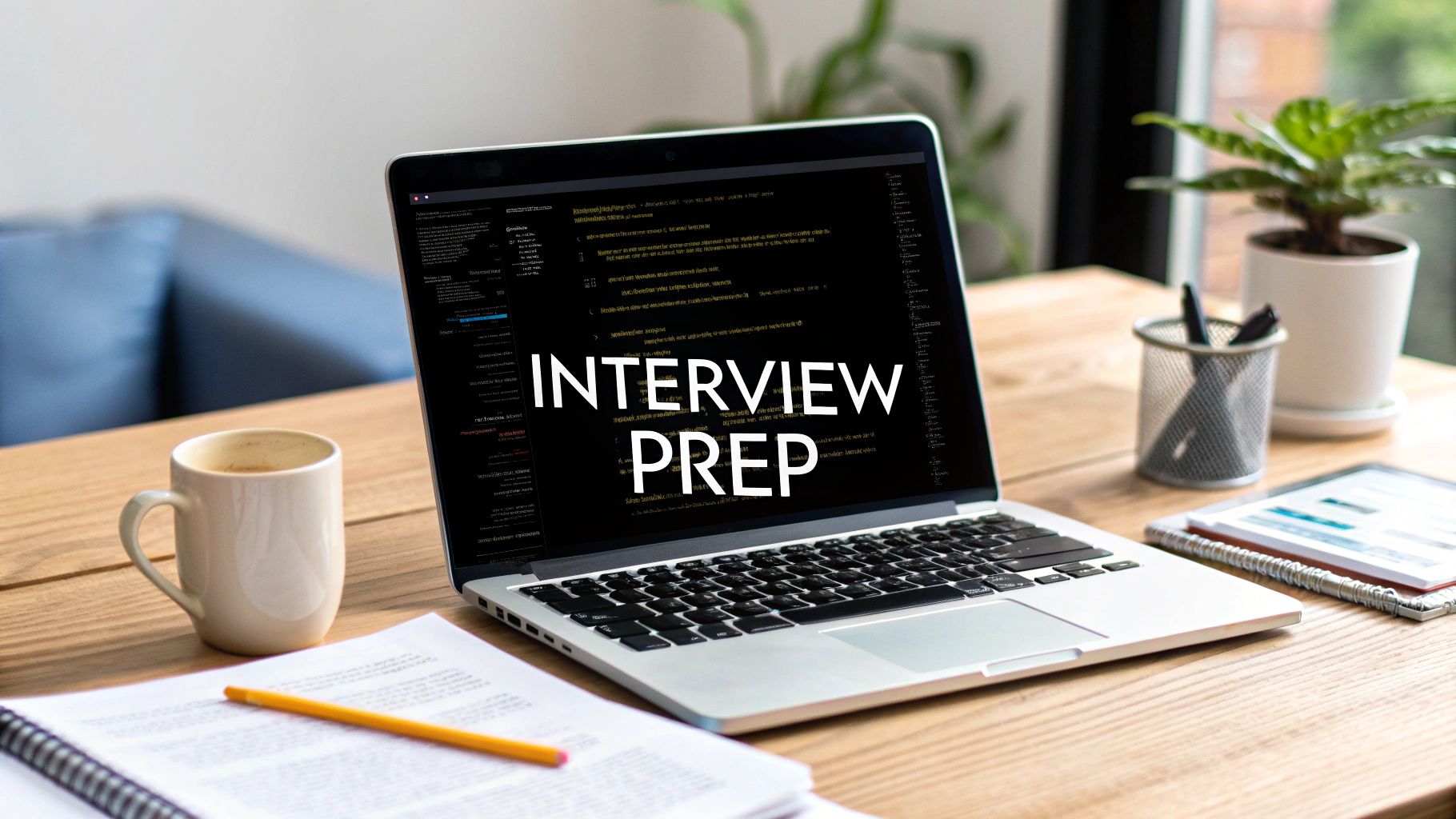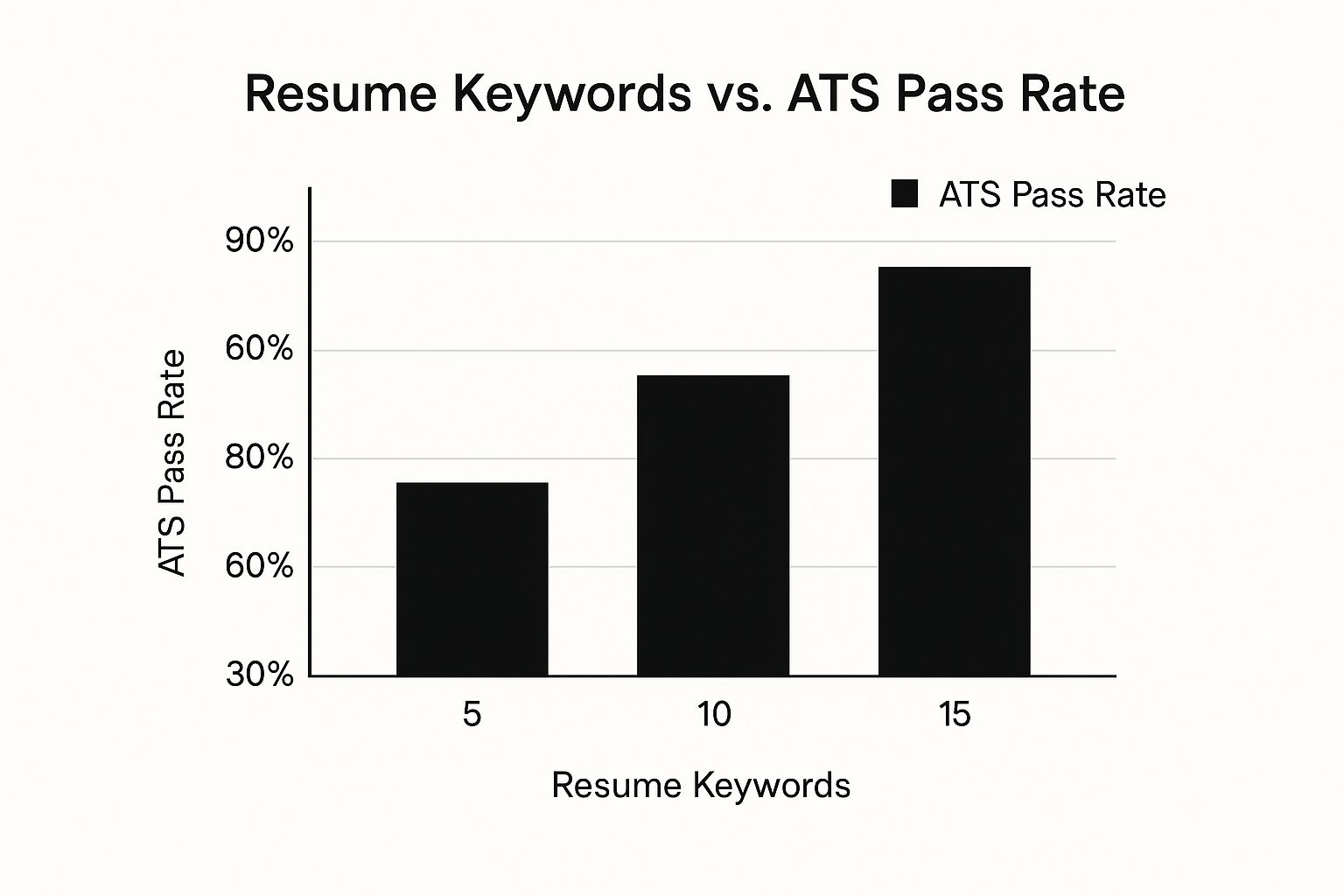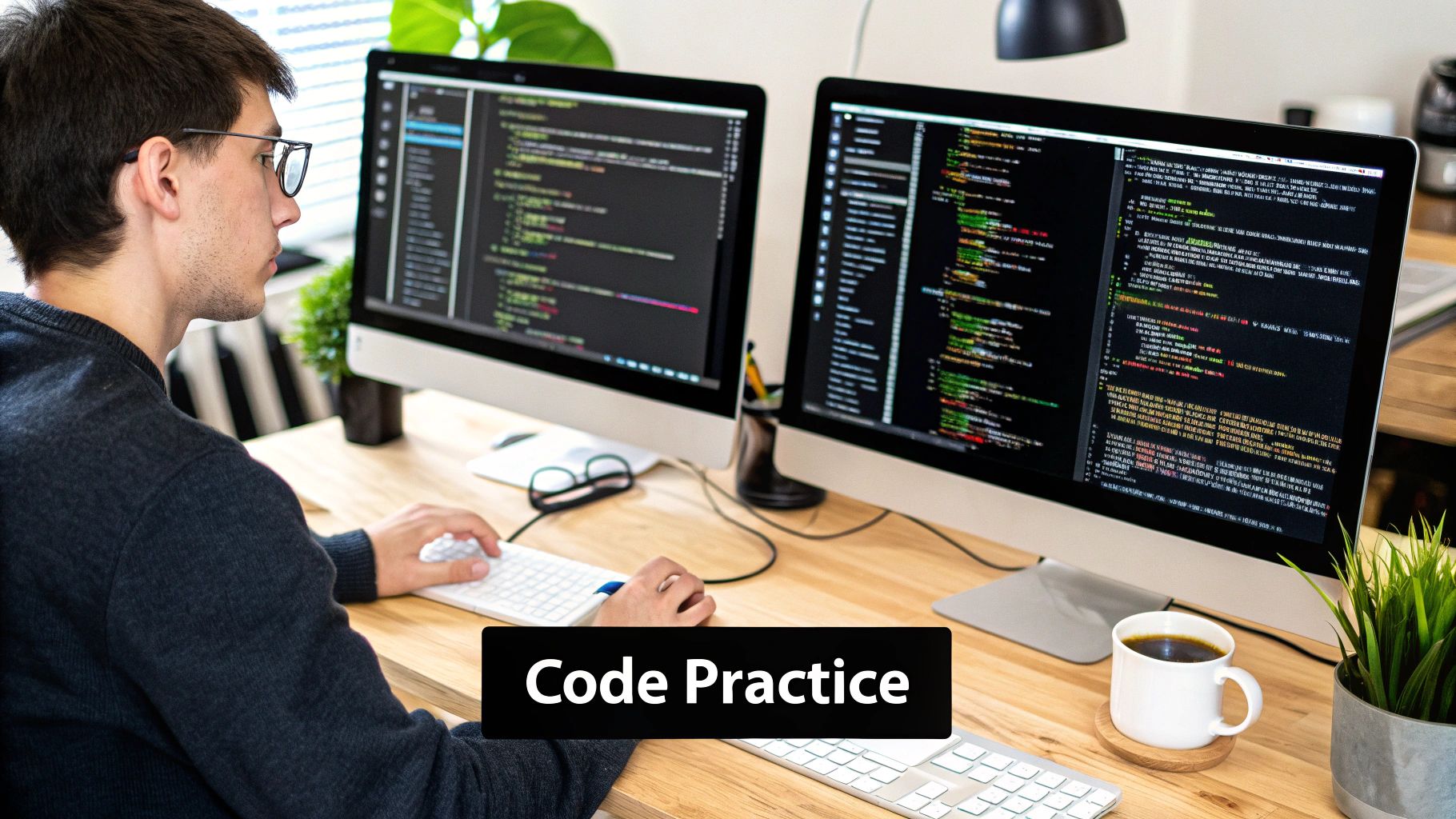A Guide to Software Engineer Interview Prep

Let's be honest—preparing for a software engineer interview isn't what it used to be. Gone are the days when you could just grind out a few algorithm puzzles and call it a day. The game has changed, and today's market demands a far more complete and strategic approach. You need to bring your A-game, which means flawless coding, a deep grasp of system design, and compelling behavioral storytelling to even get a foot in the door.
The Reality of Modern Tech Interviews
The software engineer interview process has evolved, and it's tougher than ever. It's no longer a simple test of your LeetCode prowess. We're in a fiercely competitive environment where companies have seriously raised the bar. They’re looking for candidates who can solve practical, real-world problems under pressure.
This shift is a direct response to a few factors, including the need for more robust evaluation methods. Instead of just abstract brain teasers, you're now more likely to face live proctored coding sessions, intricate system design challenges mirroring actual business needs, and intense questioning about your past projects.
Companies want to see your thought process, not just your final answer. They're looking for engineers who can write clean, production-ready code and clearly explain the trade-offs behind their design choices.
Why Preparation Is More Critical Than Ever
The landscape for software engineering interviews has gotten significantly more challenging. This is driven by sky-high employer expectations and a massive increase in competition. There are 46% fewer roles available compared to the market's peak in 2021.
This reality has created a highly selective environment where 82% of companies now expect flawless code with thorough error handling, all delivered under tight time constraints. You can explore more about the new reality of tech interviews to get a better sense of what you're up against.

Understanding this new dynamic is the first step. Your prep strategy has to be multi-faceted, hitting every key area that interviewers will scrutinize.
Core Components of a Winning Strategy
To really succeed, you need a plan that covers the main pillars of a modern software interview. Dropping the ball in any one of these areas can get you a quick rejection, no matter how skilled you are in the others.
Here's a quick look at the core components that should be part of any serious interview preparation plan.
| Prep Area | Primary Focus | Key Goal |
|---|---|---|
| Data Structures & Algorithms | Pattern recognition and optimal code | Write clean, bug-free, and efficient code under pressure. |
| System Design | Scalability, reliability, and trade-offs | Architect large-scale systems and articulate design decisions. |
| Behavioral Skills | Communication, collaboration, and ownership | Tell compelling stories that showcase your impact and teamwork. |
| Resume & Project Showcase | Impact-driven metrics and technical depth | Create a powerful first impression that gets you the interview. |
Building a plan around these four areas is non-negotiable for anyone serious about landing a top engineering role today.
A successful software engineer interview prep plan is not a sprint; it's a marathon. It requires consistent effort across technical and non-technical domains to build the confidence and skills needed to perform under pressure.
Mastering Data Structures and Algorithms

Let's be real: a deep, practical grasp of data structures and algorithms (DS&A) is the absolute bedrock of your interview prep. Trying to just memorize solutions from popular coding sites is a strategy that's doomed from the start. What you're really aiming for is pattern recognition—the ability to look at a brand-new problem and immediately connect it to an algorithmic technique you already know.
Interviewers aren't just hunting for the right answer. They want to see how you get there. That means your prep needs to be laser-focused on talking through your thought process, writing clean code when the pressure is on, and systematically checking for those tricky edge cases. These are the signals that really separate a good candidate from a great one.
Building a Foundation with Problem Patterns
Instead of grinding through a random list of problems, you’ll get a lot more mileage out of organizing your study around common patterns. This approach is way more efficient and helps build the mental frameworks you need to perform in a live interview.
I always tell people to start with the essentials before getting fancy. A solid, structured plan could look something like this:
- Arrays and Strings: Get really comfortable with techniques like two-pointers, sliding windows, and prefix sums. These pop up everywhere and are the building blocks for countless questions.
- Hashing: You need to master Hash Maps and Hash Sets. They are your go-to tools for problems involving frequency counts, fast lookups, or just keeping track of unique things.
- Linked Lists: This is where you practice manipulating pointers, reversing lists, and detecting cycles. These problems are a great test of your attention to detail and how well you can visualize memory references.
- Trees and Graphs: Kick things off with basic traversals (BFS, DFS), then graduate to more advanced concepts like topological sort and shortest path algorithms. These are critical for modeling tons of real-world scenarios.
Once you feel solid on these, then it's time to move on to tougher patterns like dynamic programming or greedy algorithms. The goal here is to build confidence and momentum with the fundamentals first.
The most effective way to solve DS&A problems is to have seen the underlying algorithms beforehand. It's nearly impossible to invent a novel, optimal algorithm on the spot during an interview. Your goal is pattern recognition, not invention.
A Practical Roadmap for LeetCode
Platforms like LeetCode are fantastic, but you can easily get lost in the sea of problems without a plan. Don't just sort by "easy" and start randomly clicking. A deliberate strategy will pay off big time.
First, knock out 20-30 easy problems for each of the major data structures. This is all about building muscle memory—getting comfortable with your language's syntax and the basic mechanics of each structure.
After that, it's time to dive into the medium-level problems. Honestly, this is where you'll spend most of your prep time, as these are the bread and butter of most technical screens. Your target should be around 100-150 medium problems that cover a wide range of patterns. Don't get discouraged if they feel like a struggle at first; that's where the real learning happens.
Finally, mix in a few hard problems, but don't obsess over them. Tackling 15-20 hard questions will seriously stretch your problem-solving skills and get you ready for those tough loops at top-tier companies.
Articulating Your Thought Process
How you communicate during the interview is just as critical as the code you write. The interviewer needs to be able to follow your logic. A classic mistake is to go completely silent for long stretches while you're thinking.
Instead, get into the habit of using a clear communication framework:
- Clarify the Problem: Always start by repeating the problem back in your own words. Ask questions about constraints, input types, and what the output should look like.
- Propose a Solution: Talk through a brute-force approach first. This immediately shows that you understand the core of the problem, even if the solution isn't the most efficient.
- Optimize: Discuss the time and space complexity of your initial idea. Then, walk them through how you can improve it, maybe by using a different data structure or a more clever algorithm.
- Code and Test: As you write the code, explain what you're doing line by line. When you're done, manually trace an example or two through your solution to prove it works and handles edge cases.
This methodical approach shows you have a structured, professional way of solving problems—which is exactly what hiring managers are looking for. It changes the entire dynamic from a scary test into a collaborative session.
How to Approach System design Interviews

The system design round often feels like the most intimidating part of the entire software engineer interview prep gauntlet. It’s not like a coding problem where there's a neat, optimal solution waiting to be found. This is a wide-open conversation about building something huge from the ground up.
Let's get one thing straight: the goal isn't to produce a flawless, production-ready architecture in just 45 minutes. That would be impossible.
Instead, the interviewer is trying to see how you think. They want to watch you handle ambiguity, ask smart questions, and defend the trade-offs you make. This is your moment to prove you have senior-level thinking and can be trusted with complex, large-scale projects.
Start by Defining the Scope
The absolute biggest mistake I see candidates make is diving headfirst into the tech. A prompt like "Design a news feed" is intentionally vague. Your first job isn't to be an engineer; it's to be a product manager. Clarify the requirements and never, ever assume.
Kick things off by asking questions that put guardrails on the problem. A few good questions right at the start will completely reframe the discussion and show your methodical approach.
- Functional Requirements: "What are the must-have features for V1? Are we just talking text posts, or do we need to handle images and videos? Are comments and likes part of the core functionality?"
- Non-Functional Requirements: "What kind of scale are we talking about? How many daily active users should we plan for? What's an acceptable latency for loading the feed? How critical is uptime?"
- Scale and Scope: "Is this for a mobile app, a web app, or both? And which is more important to optimize for: reading the feed or writing new posts?"
Asking these questions proves you’re thinking about the user and the business, not just abstract boxes and arrows. Leading this discovery phase sets a collaborative and professional tone for the rest of the interview.
Structure Your Architectural Discussion
Once you have a clearer picture of what you're building, it's time to start sketching out the high-level architecture. Don't get lost in the weeds right away. Start broad, then progressively add more detail, explaining your reasoning as you go.
Having a logical flow makes the conversation easy to follow and ensures you hit all the key points before time runs out. It's like painting—you start with the big shapes before you start on the fine details.
Think of the ML system design interview as a mini design review for a project. You first need to understand how the model moves the needle of a business goal, then dive deep into how to develop, evaluate, and serve the model at web scale.
Your discussion should naturally progress through a few key stages. Here’s a common path:
- High-Level Design: Get up to the whiteboard and draw the main components. This usually includes clients (web/mobile), a load balancer, your application servers, and a database.
- API Design: Start defining the contracts. For a news feed, you'll need something like
POST /poststo create a new post andGET /feedto fetch a user's feed. Briefly discuss what the request and response objects might look like. - Database Schema: Now, think about your data models. What tables or documents will you need? For our example, you’d probably have
Users,Posts, and maybe aFollowstable to manage the social graph. This is the perfect time to justify your choice between SQL and NoSQL. - Scaling the System: This is where you really show your seniority. How are you going to handle millions of users? This leads directly into conversations about caching, different load balancing strategies, and using message queues for async work.
Justify Your Trade-Offs
Every single decision in system design is a trade-off. A senior engineer knows this instinctively and can explain why they chose one path over another. Simply saying, "I'll use a NoSQL database," is a red flag.
A great answer is packed with context and justification. When choosing a database, for instance, you could frame it by comparing the options:
| Database Type | Best For | Trade-Offs | Example Use Case |
|---|---|---|---|
| SQL (e.g., PostgreSQL) | Structured data with strong consistency | Can be harder to scale horizontally | User profiles, financial transactions |
| NoSQL (e.g., Cassandra) | Unstructured data, high availability | Weaker consistency guarantees | User-generated content, activity feeds |
So, for the news feed, you could say: "I'm thinking of a hybrid approach. I'd lean toward a NoSQL database like Cassandra for the posts themselves. It scales horizontally beautifully, which is critical for a write-heavy system with potentially massive amounts of data. For user accounts and the social graph, though, I’d stick with a relational SQL database to ensure strong transactional consistency for that critical data."
An answer like that demonstrates a nuanced understanding. It shows you’re not just repeating buzzwords but are making deliberate, informed decisions based on the specific problem you're trying to solve. That’s the kind of thinking that gets offers for senior roles.
Telling Your Story in Behavioral Interviews
Getting the technical questions right will get you in the door, but acing the behavioral interview is what actually gets you the job. It's so easy to brush these rounds off as just "soft skills," but they carry a surprising amount of weight. This is the moment the interviewer decides if you're someone they'd actually want to work with every single day.
Companies aren't just looking for brilliant coders. They want to hire engineers who take ownership, play well with others, and don't crumble when things get tough. Your ability to tell a compelling story about your experiences is just as critical as your skill in optimizing an algorithm. This part of your software engineer interview prep requires a different kind of practice—one that’s all about reflection and good storytelling.
Beyond STAR to Real Impact
You've probably been told to use the STAR method (Situation, Task, Action, Result). It's a decent starting point, but just listing the facts isn't going to impress anyone. The real magic is in connecting those dots to show genuine impact and self-awareness.
Don't just state the result, prove it with numbers. Did your fix reduce API latency by 15%? Did your refactor cut down on bug reports by 30%? Concrete numbers make your contributions feel real and are far more memorable.
A truly great answer also has a fifth, often forgotten, element: Reflection. What did you learn? What would you do differently if you had to do it all over again? Adding this shows you've matured from the experience, a huge green flag for any hiring manager. To really nail this, it helps to understand the psychology behind the questions, like what is competency-based interviewing, so you can frame your answers effectively.
Deconstructing Common Behavioral Questions
Behavioral questions are designed to dig into specific competencies. Let’s pull apart a classic one to see how you can build an answer that really lands.
The Question: "Tell me about a time you disagreed with a teammate."
This isn't really about the disagreement. The interviewer is testing your collaboration skills, your ego, and whether you can handle conflict like a professional. A weak answer is all about proving you were "right." A strong one is about finding the best path forward for the team and the project.
Here’s a better way to structure your narrative:
- Set the Scene (Situation & Task): Quickly give the context. Maybe you and a colleague had different ideas for an API design. You preferred a RESTful approach for its simplicity, while they argued for GraphQL to minimize network calls.
- Explain Your Process (Action): This is the heart of your story. What did you do? Did you set up a meeting to whiteboard the pros and cons? Did you build a quick proof-of-concept for both to compare performance? Show that your response was proactive and based on data, not emotion.
- Focus on the Outcome (Result): Describe how it all shook out. Perhaps the data showed their GraphQL approach was superior, and you became its biggest advocate. Even better, maybe the outcome was a hybrid solution that took the best from both ideas, proving you can collaborate to find an even better way.
- Show What You Learned (Reflection): Wrap up by sharing your takeaway. Maybe you now champion the practice of aligning on technical principles before a project kicks off, or perhaps you learned a new framework for evaluating architectural trade-offs.
The goal of a behavioral interview isn't to prove you've never made a mistake. It's to prove that you learn from your experiences, take ownership of your actions, and work constructively with others to achieve shared goals.
Building Your Story Library
You can't just wing these stories in the moment. Before you even start interviewing, you need to build a "story library" of your most impactful professional experiences. I'd recommend having at least five solid examples ready to go.
- A tough technical challenge you wrestled with: This shows off your problem-solving chops and grit.
- A project where you stepped up and took ownership: This demonstrates initiative and leadership potential.
- A time you navigated a ridiculous deadline: This proves you can deliver under pressure.
- A conflict you helped resolve: As we discussed, this highlights collaboration and communication.
- A time you messed up and what you learned: This is a big one. It shows humility, resilience, and a real commitment to personal growth.
For each story, jot down the key points using that STAR+Reflection framework. Then, practice telling them out loud—to a friend, your dog, a mirror—until they flow naturally. This prep work will give you the confidence to turn what feels like an interrogation into a genuine, compelling conversation.
Building a Prep Schedule That Won't Burn You Out

The biggest mistake I see engineers make isn't fumbling a tricky algorithm; it's burning out before they even get to the final round. The urge to cram for eight hours a day is real, but it's a one-way ticket to exhaustion. Forget the sprint. We're building a marathon-ready prep schedule that actually fits into your life.
If you’re already juggling a full-time job, intensity is your enemy. Consistency is your best friend. It’s all about carving out dedicated, focused blocks of time that you can realistically stick to without torpedoing your well-being. A grueling schedule will just leave you fried when it counts.
The key is to strike a healthy balance. Your prep needs to be a mix of hands-on coding, system design theory, and polishing your behavioral stories. If you neglect any one of these, you’re leaving a massive hole in your preparation.
How to Structure Your Week
To keep from feeling completely overwhelmed, the best approach is to break your prep down into daily, bite-sized chunks. This not only prevents burnout but actually helps you learn better through consistent reinforcement. You want to make steady progress, not hit a wall.
Here’s a sample weekly rhythm I’ve seen work wonders. Feel free to adapt it to your own life:
- Monday & Wednesday (Coding Days): Set aside 90 minutes for deep coding work. For the first hour, really wrestle with one or two problems. Use the last 30 minutes to dissect the optimal solutions and understand the patterns you might have missed.
- Tuesday & Thursday (Theory & Storytelling): These are for less code-heavy lifting. Spend 60-90 minutes watching a system design video, reading a good engineering blog, or refining one of your key behavioral stories using the STAR+Reflection method.
- Friday (Review & Recharge): Keep it light. Do a quick review of the week’s concepts, or just take the day off. Seriously, rest is a strategic part of the process.
- Saturday (The Big Session): This is your main event. Block out a solid 2-3 hours for a full mock interview or a deep dive into a complex topic that’s been giving you trouble.
- Sunday (Mandatory Rest): Don't skip this. Your brain needs downtime to consolidate everything you've learned and get ready for the next week.
A consistent 90 minutes of focused study, five days a week, is far more effective than a panicked 10-hour cram session on a Saturday. Sustainability is the name of the game.
Scheduling Your Interviews Like a Pro
How you schedule your actual interviews can make or break your performance. Stacking multiple intense technical rounds on the same day is a classic rookie mistake. Your brainpower is a finite resource—you have to manage it.
One of the most effective strategies is to be deliberate about your interview timing. A senior engineer I know meticulously tracked their job search, logging about 88 hours of prep over two months for 65 interviews. They often scheduled interviews for the afternoon, leaving their mornings clear for a final warm-up.
Here are a few scheduling tips I’ve picked up over the years:
- Warm-Up Early: Try to line up phone screens or interviews with companies you’re less excited about for Monday or Tuesday. It’s a low-stakes way to shake off the rust.
- One Big Ask Per Day: As a rule, limit yourself to one heavy technical or system design interview per day. This ensures you show up to each one with a full tank of mental energy.
- Protect Your Mornings: If you can, book your interviews for the afternoon. Use the morning to review company-specific notes or solve a quick warm-up problem.
To get the most out of your study time, it's worth exploring effective strategies to increase focus and concentration while studying. This kind of thoughtful approach to both prep and scheduling ensures you walk into every interview feeling prepared, confident, and ready to do your best work.
Using AI to Sharpen Your Interview Skills
In today's tough job market, you need every advantage you can get during your software engineer interview prep. Sticking to the old playbook of just grinding problems and reading theory is still important, but it’s no longer enough. The real game-changer is bringing smart tools into your prep. This isn't about cutting corners; it’s about working smarter and getting the kind of specific, data-driven feedback that used to be nearly impossible to find.
Think of AI tools as a personal interview coach that’s on call 24/7. They can spot weaknesses you don't even know you have, offering an objective perspective that’s tough to get from human mock interviews alone. By mimicking a real interview environment, these platforms get you ready for the high-pressure reality of a modern tech screen.
AI for Technical Coding Practice
When you're deep in a coding problem, nothing beats instant feedback. That’s why so many engineers are turning to AI-powered platforms to get ahead. I always recommend a solid 1-2 hours of focused coding practice every day, and these tools ensure that time is spent effectively. Platforms like Interviewing.io and LeetCode’s AI features now offer automated challenges that give you real-time feedback on your code’s efficiency, correctness, and style, much like a live interviewer would.
For example, LeetCode now uses AI to offer hints and break down solutions, helping you understand the why behind the code. You can find more about tech interview trends on gdhinc.com.
Here’s a look at the LeetCode platform, where this AI integration comes to life.
This kind of interface lets you dive into problems, get immediate analysis on your submissions, and see how your solution stacks up against others. It’s a powerful feedback loop.
AI for Behavioral Interview Prep
Your coding skills might get you in the door, but how you talk about your work is what often seals the deal. Behavioral interviews are critical, and AI can help you nail them. Tools like Yoodli let you record yourself answering common behavioral questions and then analyze your performance. You'll get feedback on everything from your speaking pace and filler words to the clarity and confidence of your answers.
Here’s how a tool like this can help you sharpen your storytelling:
- Find weak spots: It can pinpoint the exact moments where your story gets fuzzy or you start sounding hesitant.
- Polish your delivery: You can practice cutting out filler words like "um" and "like," making you sound more professional and articulate.
- Ensure clarity: It helps you check if your STAR-method answers are actually easy to follow and clearly demonstrate your impact.
The real value of AI in interview prep is its ability to provide immediate, unbiased feedback at scale. It’s like having a tireless coach who can run drills with you endlessly, sharpening your skills with each repetition.
This constant practice builds the muscle memory you need to stay cool and perform your best when it really counts. At ParakeetAI, we’re all about using technology to build both competence and confidence. For more ideas on how AI can help you across your entire job search, check out our guide on the ParakeetAI blog. When you strategically add these tools to your routine, you’re no longer just passively studying—you’re actively training in a feedback-driven system designed to get you offer-ready.
Common Questions About Interview Prep
Even with the best-laid plans, a few tricky questions always seem to pop up as you get closer to the big interview day. Let's walk through some of the most common ones I hear from engineers and get you some straight, no-nonsense answers.
How Many LeetCode Problems Should I Solve?
This is the big one, isn't it? Everyone wants a magic number, but the truth is, quality always, always beats quantity. Instead of just grinding to hit a specific count, you should be focused on mastering the core patterns behind the problems.
If you're looking for a ballpark number, aiming for 150-200 well-understood problems is a solid goal. This gives you enough exposure to different topics and difficulties without leading to burnout.
But here's the real test: Can you confidently take on a medium-level problem you've never seen before and solve it in under 40 minutes? And I mean solve it while clearly explaining your thought process and considering all the edge cases. When you can do that, you're ready.
Practicing System Design Without Experience
I get it—this feels like a classic chicken-and-egg situation. How do you design systems if you've never built one at scale? The good news is, you absolutely can.
Start by becoming a knowledge sponge. Dive into the engineering blogs from places like Netflix, Uber, and Meta. You’ll see exactly how they approach real-world design challenges.
Then, you have to get your hands dirty. Pick an app you use every day—say, Instagram or Twitter—and try designing it from the ground up on a whiteboard. Force yourself to talk through every decision out loud, from API endpoints to database schema. This is where mock interview platforms really shine; getting feedback from a senior engineer who can spot flaws in your design is invaluable.
The biggest mistake I see is candidates jumping straight to drawing diagrams. Always start by asking clarifying questions. What are the functional and non-functional requirements? This shows you think like a senior engineer and saves you from building the wrong thing.
Handling a Problem You Have Never Seen Before
First things first: don't panic. Take a deep breath. Your interviewer is watching how you handle pressure just as much as they're watching you code.
Start by talking. Ask clarifying questions to make sure you understand the prompt, the constraints, and what the expected inputs and outputs are. Then, think out loud as you start breaking the problem down. It's completely fine to begin with a simple, brute-force solution.
Often, the journey is more important than the destination. Showing how you methodically work from a basic idea and iterate towards a more optimal one reveals far more about your problem-solving skills than just spitting out a perfect answer instantly.
Ready to walk into your next interview with an AI assistant by your side? ParakeetAI gives you real-time, resume-tailored answers and coding support so you never get stuck. Check out ParakeetAI today and land the job you deserve.




